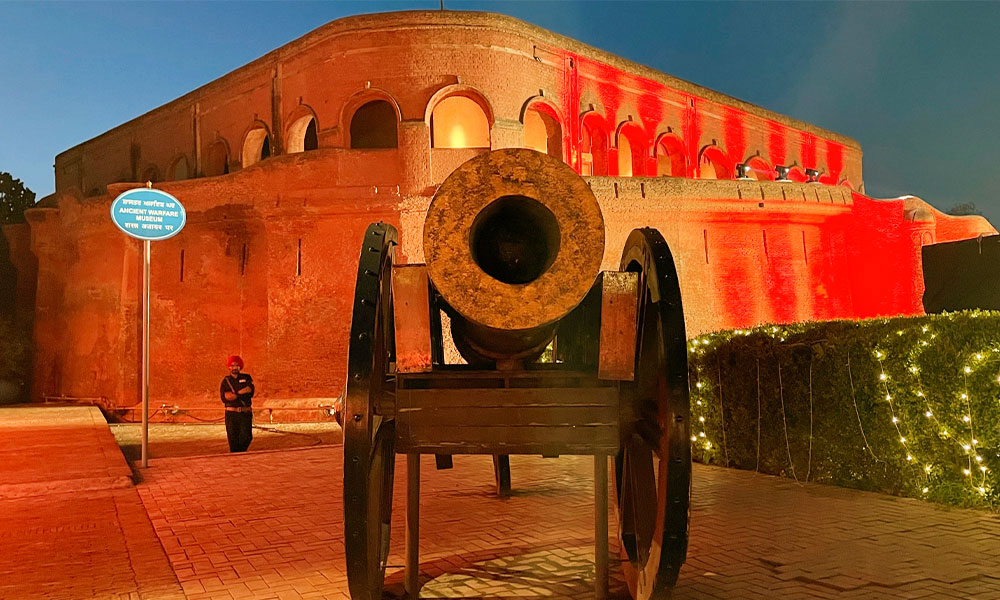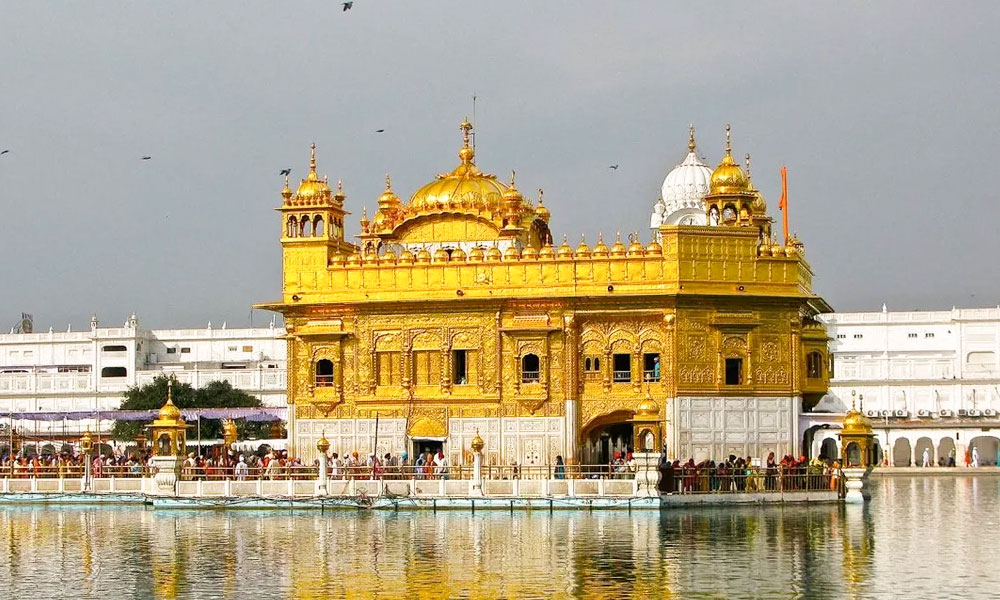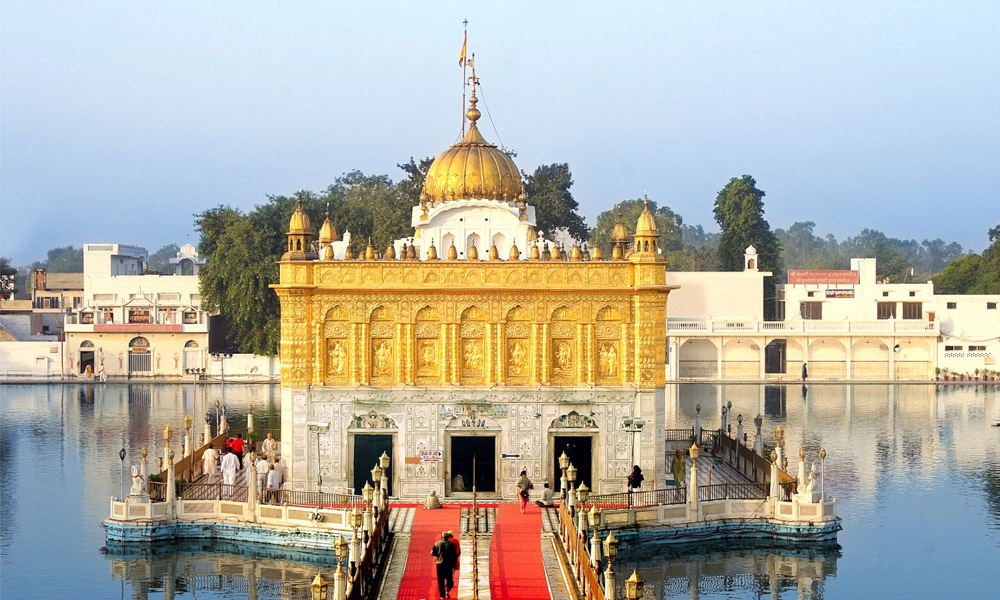
7 Tourist Places in Amritsar, Punjab
Although Amritsar is the holiest city for Sikh pilgrims, this stunning location in Punjab is visited by visitors of all faiths and interests. Akal Takht, Jallianwala Bagh, Gobindgarh Fort, and the Golden Temple are among the well-liked tourist destinations in Amritsar. The Golden Temple and other historic buildings may be found in the Old City, which lies south of Amritsar station. On the other hand, the city’s north side is home to upscale dining establishments, lodging facilities, open-air residential areas, and other dazzling examples of the modern-day prosperity of the city. Let’s examine each of the Amritsar’s sites of interest in more detail:
The Golden Temple, one of India’s most magnificent temples and the most important sacred landmark for Sikhs, is certainly the main attraction of any Amritsar tourist tour. One of the main attractions in Amritsar is the Golden Temple, additionally referred to as Darbar Sahib or Shri Harmandir Sahib. Every day from 6 am to 2 am, the temple complex is open, allowing guests to take in the beautiful evening reflections in Amrit Sarovar.
There is a narrow bridge that leads to the two-story building in the center of the holy pool. After bathing in the marked spots of the pool, pilgrims can bow their heads in the temple. The Central Sikh Museum here displays a gallery of paintings illustrating stories of martyred Sikh leaders. There is also a well-known langar (dining hall) in the Golden Temple where complimentary meals are provided to all guests 24/7.
Jallianwala Bagh is one of the most well-known tourist destinations in Amritsar. This 6.5-acre area, which is five minutes’ walk from the Golden Temple, is the location of the legendary Baisakhi massacre that took place in Amritsar in 1919. The bullet holes on the walls are still visible to tourists today. Gobindgarh Fort, one of the latest destinations in Amritsar, is located in the center of the city and first welcomed tourists in 2017.
After their tour in Amritsar, visitors can continue 32 kilometers west to the Wagah town. The Indian Border Security Force (BSF) and the Pakistani Rangers conduct the Wagah border ceremonial every evening for two hours at the border gate. About 35 kilometers from Amritsar lies the historical site of Pul Kanjri, where buildings including a mosque, temple, and pond were constructed during the reign of Maharaja Ranjit Singh.
Lal Devi, a saint, is the subject of the Hindu cave temple Mata Temple. There is also another center of devotion next to the Lohgarh gate, named Durgiana Temple or Sitla Mandir. Additionally constructed in the middle of a medium-sized lake, it echoes the design of the Golden Temple. More well-liked tourist destinations in Amritsar include the Partition Museum, the Summer Palace of Maharaja Ranjit Singh in Ram Bagh Park, the Maharaja Ranjit Singh Panorama, and Ram Tirth.
Wagah Border in Amritsar

Wagah Border is the only road border between India and Pakistan. Every evening, the Beating Retreat Ceremony is held here to honor the lowering of both nations’ flags and the closing of their borders by their militaries. The Wagah Border, a significant crossing point between India and Pakistan, is situated close to the village of Attari. Its main draw is its energetic “Lowering of the Flags” event, for which it is renowned. On a global scale, this ritual is often referred to as Beating Retreat. Observing the Wagah Border Parade is one of the most thrilling tourist activities in Amritsar.
History Of Wagah Border
The Wagah Border, commonly known as the Berlin Wall of Asia, is the only road that separates Pakistan and India. Situated 23 km from Lahore and 28 km from Amritsar, this border is situated along the Grand Trunk Road. The Beating Retreat Ceremony was started in the year 1959 on the agreement of the government of both the countries. Every evening, there is a ceremony to officially close the boundaries between the two nations and to lower the flags.
Wagah Border Ceremony
This popular event happens every evening just before dusk. This ceremony is carried out at the border by Pakistani Rangers and Indian Border Security Force soldiers. This electrifying ceremony begins with a booming parade by the soldiers and ends with a lowering of flags on both sides. The border gates open as the sun sets, and a soldier from each side steps forward to shake hands with the other and fold their flags. Attending the Wagah Border Parade is highly recommended since it is an amazing spectacle.
Facts About Wagah Border:
- The marching with the very high lifting of legs is called the Goose Marching.
- The Wagah Border ceremony is 45 minutes long.
- Anybody can watch this ceremony free of cost.
- The ceremony is carried out by India’s BSF Jawans and Pakistan Rangers.
- The ceremony is postponed during the tension or war-like situation between the two countries.
Akal Takht in Amritsar

Akal Takht Sahib, one of the five Sikh takhts, is located within the Golden Temple, also known as the Harmandir Sahib. The phrase “throne of the timeless one” literally describes Akal Takht. General meetings were conducted there, and numerous significant decisions were made. Out of the five takhts, the oldest is the Akal Takht located in Amritsar.
History of Akal Takht Sahib:
The construction was started by Shri Guru Hargobind in 1606. This foundation was established by the sixth Sikh Guru with the intention of establishing a focal point for the administration of justice and the discussion of temporal matters. After the building was finished, Guru Sahib presented two swords, one representing temporal authority and the other representing spiritual authority.
Role of Akal Takht Sahib in Amritsar:
The designated leader of Akal Takht Amritsar is still referred to as the Jathedar. A Jathedar has been assigned to each Akal Takht. Singh Sahib Giani Gurbachan Singh is the Akal Takht jathedar at the moment. The SGPC, or Shiromani Gurdwara Parbandhak Committee, appoints the jathedars of various takhts.
5 Akal Takhts of Sikhism:
The Sri Akal Takht, Sri Damdama Sahib, Sri Keshgarh Sahib, Sri Hazur Sahib, and Sri Patna Sahib are the five Akal Takhts of Sikhism. The Golden Temple in Amritsar is home to Sri Akal Takht. The settlement of Talwandi, which is close to Bhatinda, is home to Takht Sri Damdama Sahib. Takht Sri Hazur Sahib and Takht Sri Keshgarh Sahib are located near Khalsa, Maharashtra, on the banks of the Godavari River. The Takht Sri Patna Sahib is situated in Patna, the capital city of Bihar.
Gobindgarh Fort in Amritsar

One of the most significant historical sites in the state is Gobindgarh Fort Amritsar, which is referred to as the “essence of Punjab.” The Gobindgarh Fort, which occupies 43 acres, was built by Maharaja Ranjit Singh after Gujar Singh had started building on it. The fort was dubbed the “Guardian of the holy city of Amritsar” since it was constructed to defend the city against attack.
Gobindgarh Fort history
The history of Gobindgarh Fort began with the start of construction in 1760. The 258-year-old fort was first held by the Misl Clan before being taken in 1809 by Maharaja Ranjit Singh, the powerful ruler of Punjab. In honor of the 10th Sikh Guru, Shri Guru Gobind Singh, he dubbed the fort “Gobindgarh.” The British eventually conquered the fort in 1849 following the Second Anglo-Sikh War.
After independence, Gobindgarh Fort was guarded by the Indian Army until 2006. At that point, the Indian government acknowledged the fort’s historical significance and gave the Punjab government authority to restore it.
Public access was granted and the Gobindgarh Fort in Amritsar was designated as a historical monument. A must-see is this medieval fort, renowned for its amazing live shows including the Spirit of Punjab live show, Kanda Boldiyan Ne (Light and Sound show), and 7-D sher-e-punjab (Lion-of-Punjab) on Maharaja Ranjit Singh.
Jallianwala Bagh Massacre

One of India’s most significant historical sites is Jallianwala Bagh. Jallianwala Bagh, which is situated in the holy city of Amritsar, is just a short walk from the famous Harmandir Sahib/Golden Temple. The massacre at Jallianwala Bagh happened on April 13, 1919. Hundreds of people were killed and numerous others were injured when the British soldiers opened fire on a large gathering of unarmed Indians at Jallianwala Bagh in Amritsar. Even after a century has passed since the Jallianwala Bagh Massacre, millions of Indians are still deeply affected by the horrifying event. This massacre was a turning point in Indian history and led to many Satyagrahis movement. The Jallianwala Bagh Massacre shook the entire country and many people came out to participate in the freedom fight.
When India was ruled by the British in 1919, Jallianwala Bagh Amritsar began to have a tragic history. On April 13, Vaisakhi, the birth of Khalsa, was observed. Thousands of Sikhs, Hindus, and Muslims flocked to the Jallianwala Bagh to remember the day that Shri Guru Gobind Singh established the Khalsa Panth. None of the people that they were soon to become victims of one of the most cruel mascaras in the history of mankind.
Facts About Jallianwala Bagh Massacre
On the day of the massacre, many people gathered at Jallianwala Bagh to celebrate Baisakhi, one of the most important festivals in Punjab. The one escape in the bagh was blocked during the raid, resulting in a large number of casualties. It is also said that firings stopped only after the British army ran out of ammunition. Another name for the Jallianwala Bagh Massacre is the Amritsar Massacre.
Visit the Jallianwala Bagh in Amritsar while you’re there to ensure that history is passed down from generation to generation and the sacrifices made by our freedom fighters are never forgotten.
Tarn Taran Sahib in Amritsar

Taran Tarn Sahib was established in Amritsar by Sri Guru Arjan Dev Ji, the fifth Sikh Guru. The revered Gurudwara is a popular tourist destination with buildings in the Mughal style. Every day from early in the morning till late at night, the Gurudwara hosts kirtan. The Gurudwara’s front is covered with gold sheets, while its interiors are decorated with paintings and glass pieces.
About Taran Taran Sahib Sarovar
The Tarn Taran district’s administrative center is Tarn Taran Sahib in Amritsar, which is situated in the Majha area of Punjab. In addition to acting as the municipal center, this location is significant for Sikh pilgrimages. With a circumference of around 1.5 kilometers, the sarovar (pond) is greater than the one at the Golden Temple in Amritsar.
Golden Temple in Amritsar

The Golden Temple, also called Sri Harmandir Sahib, is a highly revered Sikh shrine that represents human brotherhood and equality. The gurudwara emphasizes the principles of the Sikhs and symbolizes their unique heritage and identity. The Sikh text, Sri Guru Granth Sahib, was originally deposited at Sri Harmandir Sahib on August 16, 1604, following its compilation. Irrespective of their caste, anybody can find spiritual comfort and religious fulfillment at this calming location. The Central Sikh Museum, Har ki Pauri, and the Monument of Sikh Victory on Delhi are the tourist sites located within the Golden Temple Complex.
History of the Golden Temple:
Like the temple itself, it is interesting. The preparations to excavate a holy tank and construct a town settlement in the region were initiated by the third Guru Sahib in 1570. Inspired by his vision, the fifth Guru Sahib started work on a central site of worship in 1588. The following few decades saw multiple attacks on the Punjab Golden Temple, but the damage was eventually repaired. The temple compound was expanded by the sixth Guru Sahib. Maharaja Ranjit Singh kindly finished the gurudwara’s gold plating in 1830, which allowed him to decorate it out. It goes without saying that the history of the Amritsar Golden Temple is as golden as the temple.
Langar Sewa at Golden Temple:
At Harmandir Sahib, the vegetarian food offered at langar sewa consists of rotis, rice, daal, a vegetable dish, and kheer. Every day, the Golden Temple provides services to almost fifty thousand individuals. Around 5,000 people can be served at once by the temple.
Facts About Golden Temple:
It is believed that Lord Buddha once meditated at the Golden Temple, a sacred site. The place is open to all caste, religion, and creed. Golden Temple has the biggest and largest free kitchen in the entire world.
Durgiana Temple in Amritsar

The Durgiana Temple, also called the Laxmi Narayan Temple, is one of the most significant Hindu temples and is situated in Punjab’s Amritsar area. The Hindu goddess Durga is the source of the name of Durgiana Mandir, where idols of Lord Vishnu, Goddess Laxmi, and Goddess Durga are also worshipped.
The history of the Durgiana temple began in 1921 when Guru Harsai Mal Kapoor ordered its construction. Inspired by the captivating architectural style of the Golden Temple, a well-known Sikh shrine, this new temple was constructed. Durgiana Temple, like the Golden Temple, is situated in the centre of a lake. Access to the main temple area is provided via a bridge that is constructed across the lake and resembles the Golden Temple bridge. The structure of the dome and the canopies also resembles that of the Golden Temple. After the construction of the temple was completed, Pandit Madan Mohan Malviya inaugurated the auspicious temple by himself.
In 2013, renovations were also made to the Durgiana Temple in Amritsar. The renovation plan included for adding extra outdoor theatre space, a large parking lot, and additional worship spaces.
Durgiana Temple is a must-visit place for pilgrims, and spiritual seekers, during their visit to Amritsar.
The people of the city are extremely sociable and show great hospitality. For Budget Hotels in Amritsar, you can visit Hotel Global Inn Amritsar by T&G Hotels and Resorts for your comfortable stay.
F-13/13, Dlf Phase 1, Gurgaon
Haryana – 122002, India
+91-9289261222, 0124-4377445
bookings@tnghotelsandresorts.com
- FAQs
- Careers
- Help Desk
- Contact Us
- Sitemap
- Testimonials


